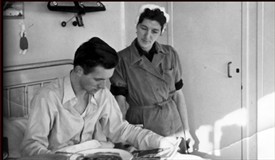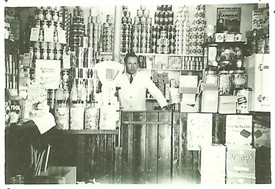A boy's memories of Hothfield in the early fifties

John's mum had a job at Hothfield Hospital
Courtesy John Roders

John remembers buying broken biscuits from George Sainsbury's shop
Photo courtesy of Alf Jobber who worked for George
Huts, bogs, school, pub, the Policeman, odd-jobs and a new council house
By John JS Roders, now in Canada
Hothfield Huts Camp
When I say a house, I mean it was just an old decaying hut, but it was a house to us.
During the Second World War, over four hundred Nissen huts had been built on the common to accommodate army personnel. With a shortage of places to live in post war England, the Ashford District Council, were using the vacant huts to house families. Although Hothfield was a picturesque little village, Hothfield Hut Camp had a reputation as a deprived area with rundown living conditions. It was here in 1951; Tilly, my mother, my sister Karen and I found ourselves living.
We passed by the Hothfield Common many times on our way between Charing and Ashford, but my mother never gave it a second thought as a place to live. The huts were very basic; a half round corrugated metal roof supported by a cement floor. Inside there was cheap-whitewashed wallboard lining the walls, which had warped from the cold and the damp. The metal windows were draughty and covered in rust and cobwebs. The floor showed signs of a mice infestation. The rooms were divided into three separate areas. The front room was the kitchen-living area with a sink and a cold-water tap. A coal fireplace with an open grate and attached oven sat in the middle of the room against the inside wall. The center room was our bedroom. It was close to the fireplace so it pick up some warmth from the living area. The back room had two small windows and was dark and musty. It was used mostly as a play area when the weather was bad or as the detention room when my sister or I misbehaved. Outside, was a small shed that had a large metal bucket with a wooden seat. This was our toilet. The bucket needed to be empted at a central septic pit when full. A good friend of my mother’s, Tom Buss, did this little chore. The shed also doubled as a coal storage area.
Soon after we arrived, my mother took Karen and me down to register for school, located on the corner of Hothfield common in the village. The school was constructed of bricks and mortar and it was built by Sir Henry Tufton in 1874. The school had three main classrooms, with a cloakroom and small hand-washing sink for each room. The playground was dirt with four or five large fir trees growing in the yard. These trees were considered home base in games of tag. Outside the fence was a large playing field. The toilets were outside at the back of the school, and on the roof was a small steeple that housed a bell to summon children to class. A central open coal fireplace heated the school and warmed our cold hands and feet on a winter’s day. At the back of the playground was a large concrete air raid shelter, which was built during World War II. At the far end of the playing field, near the cross roads of Cade and Station Road, stood another large concrete pillbox which was demolished in the late fifties.
The Head Mistress, Miss Bottle, made us very welcome. The school catered mostly to Hothfield children. They ranged in age from five to eleven years old, with some students coming from Little Chart and Pluckley. Every morning at recess, all students were given a free bottle of milk and at noon, a canteen van would arrive at school with hot dinners. This cost my mother five shillings a week for my sister and me to have a hot meal at lunchtime. Some children did not care for the mobile meals, brought sandwiches from home instead. I had no complaints!
There was no school library at that time, so once a month a large dark blue book van would make its way around to rural schools giving children the opportunity to access books to help with their schoolwork. We could choose two books per visit as long as one of the books related to our schoolwork. Parked in the schoolyard, it was obvious by the graffiti scrawled in the dust on the side of the van, that it had had been to other schools. One of Miss Bottle’s strictest rules was that when the library van came to our school no one was to go near it until it was their turn to get books. She was very proud of the fact that none of her students ever defaced the vehicle.
Like fleas to a dog, though, it was very hard for the boys to stay away from the swamps.
Because the school was situated on the common, Miss Bottle had another strict rule. No students were allowed to go anywhere near the bogs at recess.
In the spring, it was a great place to hunt for frogs, slow worms, and newts. There were many times, while in the pursuit of some aquatic trophy, the school bell would ring and in a mad dash to get back to class, students would inevitable end up with a wet foot or two. This meant they had to sit through afternoon classes with wet feet. There were times when the teacher would ask the rhetorical question, “Has anyone been playing in the bogs at recess?” No one would ever admit it, but the puddles under some desks were a dead giveaway.
As far as discipline went, I do not remember any kinds of corporal punishment on Miss Bottles watch, although that did change when Mr. Perkis became principal. Mrs. Shersby was the music teacher. She had a piano in the corner of her room. Any misbehaviour and students would find them selves standing behind it for five to ten minutes, depending on the severity of the behaviour. She also had a large jar of sweets standing on her desk. This was a reminder to students that if they had not been sent behind the piano more than once that week, they got to choose something from out of the jar at the end of the week. Every Friday afternoon, just before dismissal for the week, Mrs. Shersby would come around with the sweet jar. Many times, she would give me a pass saying, “Now John, I don’t like to do this, but you must try harder next week to be good.” This was very little comfort to me, as the other children sat at their desks smacking on a large gob-stopper. I would try to be very nonchalant about it, but I was green with envy.
On the other hand, Miss Bottle’s discipline came in the form of a good telling-off if students were disobedient. Embarrassing a student in front of the whole class, with her high-pitched voice, she let everyone know all about the latest blunder. If students had been particularly unruly, she would give them a good hard shaking and in doing so, try to shake some sense into them, I suppose. All the time, though, while trying to keep a straight face at this head-jarring experience, behind her back, the other boys chuckled away as they mimicked her. I went through one of these up close and personal episodes one time with Miss Bottle; she had caught me flicking bars of soap around the cloakroom.
Popularity of games would come and go. One week it would be Hopscotch, with one or two games scratched out in the playground. Another week, it might be playing five stones. There was always a game of marbles going on with the boys. The girls skipped rope and sang out their little nursery rhyme, “I like coffee, I like tea, I like Johnny, and he likes me,” or replacing the name with any other boy they could embarrass that happened to be in range of their voices. Conkers were all the rage in the fall, everyone trying all kinds of tricks to harden their conkers and knock out the competition.
It was an exciting day when they first began logging the land opposite the school to build the new housing estate, even more exciting the day my mother got her keys to number seven Common Way.
Hothfield was a great place to grow up in as a kid, even with some of its faults and failures. I have many good memories of school, church choir and the Lads Brigade and running wild on the common, with friends that I still keep in touch with today, some forty-five years later. Mr. Forman (The barber) and Mr. Sainsbury, the local shop owners where I could buy broken biscuits for half price. Mr. Spicer, the butcher, where my mother would buy me a steak every Friday. Mr Manson, the local publican, where my mother would send me to pick up her favourite “Milk Stout,” when she felt like celebrating some special occasion. Mr. Doors, the well-regarded member of the Hothfield constabulary, who found it necessary from time to time to pay us a little visit.
There was always opportunity to make a little extra pocket money around the village. Mr. Coles always needed some hoeing done and there was strawberry picking at Pluckley. A couple of beats each year, fifteen bob and a large bottle of Tizer, not a bad days pay for a walk the woods. I could always get a bit of work on the weekend or holidays with Mr. Matthews pulpwood logging.
A penny for the Guy at Guy Fawlk’s time always came in handy for a few bangers. We would start building a large bon fire on the common and on Guy Fawlk’s night, parents would sit on the wall along School Road and watch the festivities. When the fire finally burned down, we would bake potatoes and chestnuts in the hot coals. A little carol singing at Christmas time would always add to our party coffers. I remember one Christmas, Mrs. Tufton had raised turkeys and she paid a half crown for every turkey that you killed and plucked. This was very good money at that time. On weekends, I did a meat round for Spicers Butcher Shop.
I hope some of these reflections ring a bell with you folks in the village and bring back pleasant memories. Thanks for listening.
John Roders, Canada
"Monkery Bottom - A memoir" by John JS Roders
John has written his mother's life story including a somewhat nomadic life around the Charing and Hothfield areas. The last three chapters of the book, written in John's own style, cover his life at the huts camp in great detail including accounts of the Hothfield boys being banned from public buses and having their own service direct to and from the school! His book is available from good book sellers or the usual on-line websites (ISBN 978-1-4269-2146-9, Trafford Publishing).
For more details about his captivating book see: http://monkerybottom.ca
Read more excerpts from John's chapter on the huts camp and also about Hothfield life